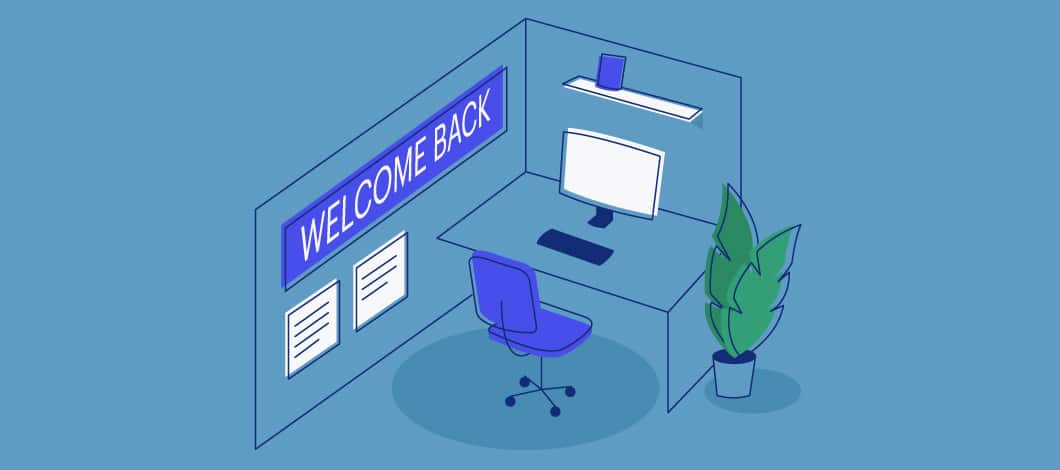As furloughed workers return amid COVID-19 concerns, employers face new challenges.
Here’s how to handle the most common issues of bringing your staff back to work. We’ll cover:
- What a work furlough is
- How furloughs differ from layoffs
- What to do when you need to furlough workers
- How to write a furlough notice letter
- How to plan for bringing back furloughed workers
- How to write a letter of reinstatement to an employee returning from furlough
Learn what you need to know about how to manage furloughs and how to bring furloughed employees back to work.
What Is a Work Furlough?
A work furlough is a temporary leave of absence involving a reduction or elimination of work hours. Furloughed workers remain employees, but for the duration of the furlough, their hours are reduced or they cease putting in hours altogether. If employees aren’t working, they typically don’t accrue wages or salaries.
Alternately, some employers may require employees to use accrued paid time off or sick leave during furloughs. However, this usually doesn’t cut costs, so most employers avoid it. Furloughed workers typically continue drawing benefits such as healthcare, although this may vary.
-
Legally Speaking
Employees on furlough can’t perform any type of work. This includes tasks such as checking email or making work-related telephone calls. If employees do engage in such behavior, employers may be liable for legal claims of unpaid work. To avoid this, employers should restrict employee access to company email accounts, phone numbers, websites and digital resources during furloughs.
Furloughs normally have a limited duration. The duration may be set or indefinite. After the expiration of the furlough, employees can come back to work or resume normal hours.
Exact terms of furloughs vary by employer and employee. Employers can set terms. In some cases, hours are merely reduced. In others, they are eliminated for a set number of days, weeks or months.
Furloughs may be one-time events, or they may be scheduled in periodic cycles. For instance, an employee may be furloughed for two weeks, come back in for two weeks and then go back on furlough for another two weeks.
Work-time reduction is handled differently for hourly workers than for salaried workers. Hourly workers can have their work time reduced in hourly increments. However, because salaried workers aren’t paid by the hour and must be paid a full week for any week in which they put in time, according to the Fair Labor Standards Act, employers reduce their time in weekly increments.
Under the Coronavirus Aid, Relief and Economic Security (CARES) Act, furloughed workers can apply for unemployment benefits. Furloughed workers who receive unemployment benefits remain employed by their employers.
Furloughs vs. Layoffs
Furloughs differ from layoffs in several important ways:
- Laid-off workers cease to retain their status as employees, whereas furloughed workers remain employees.
- Laid-off workers lose benefits, whereas furloughed workers normally retain benefits.
- Layoffs may be temporary or permanent, whereas furloughs are normally temporary.
- Laid-off workers must normally be paid for accumulated paid time off, whereas furloughed workers don’t normally receive such payouts.
- Laid-off workers must continue to seek work to qualify for unemployment benefits, whereas furloughed workers aren’t required to seek work.
In general, the main difference between furloughs and layoffs is that furloughed workers remain employed, while laid-off workers don’t.

How to Place Workers on Furlough
The U.S. Chamber of Commerce has published guidelines for employers considering furloughs or layoffs in response to the COVID-19 pandemic. The Chamber of Commerce makes a number of major recommendations:
- Develop a furlough plan that minimizes disruptions to your business, favoring reduced hours or cycles of short furloughs with temporary work when possible
- Be transparent with staff about financial reasons for furloughs, stressing that workers aren’t being laid off or punished for underperformance
- Provide clarity about which benefits remain in place during furloughs
- Don’t allow employees to engage in work-related emails or phone calls during furloughs
- Stay in touch with employees during furloughs and provide emotional support by expressing empathy and responding to questions
Following these guidelines will help make furloughs more manageable for everyone involved. Make sure you comply with all legal requirements:
- The Fair Labor Standards Act requires salaried workers to be compensated for a full week’s work if they put in any hours, so be sure to take this into account
- The National Labor Relations Act requires employers with unionized employees to negotiate furlough terms with unions
- Equal Employment Opportunity laws forbid discrimination when selecting which employees to be furloughed
- The Worker Readjustment and Retraining Notification (WARN) Act requires employers with 100 or more employees to provide 60-day advance notice of layoffs or furloughs to employees, union representatives and certain government entities
- Employee benefit agreements and individual employee contracts may require additional considerations
To ensure full compliance with all applicable laws and regulations, consult a qualified legal expert.
How to Write a Furlough Notice Letter
Ideally, you should discuss furlough decisions with employees verbally and explain the reasons for your decision. However, for clear communication and for legal documentation, you should also notify employees in writing. A furlough notice letter should include the following sections:
- An announcement of the decision and your company’s reasons for making it
- An explanation of when the furlough begins, how it will affect the employee’s work hours and when it is expected to end
- A notification that the employee is eligible to apply for unemployment benefits
- An assurance that your company will continue to communicate with your employee and a request that they keep their contact information updated
- A request that the employee notify your company if they take another job while furloughed and don’t intend to return to your company
A shift-change letter to an employee whose hours are only being adjusted would follow a similar format, minus the section about unemployment benefits. (Here’s a tip: Search online for a sample notice of temporary layoff or furlough because of the coronavirus to use as a template.)
How to Bring Back Furloughed Workers
Bringing workers back from furlough involves similar considerations to placing them on furlough. Planning and transparent communication lay the groundwork for a smooth transition back to work. Follow these steps when bringing workers back from furlough:
- Plan your new policies and procedures that will go into effect after furlough ends
- Notify employees of the opportunity to return to work
- Require a response
- Anticipate negotiations
Here’s how to implement each of these steps.
1. Plan Your New Policies and Procedures
Before bringing furloughed workers back, it’s important to plan the transition. Workers will need to adapt to any safety measures you’ve implemented in response to COVID-19, which may require notification, testing and training. You may also have to address changes to workers’ duties or hours, as well as any human resources issues affecting benefits or payroll.
Here’s a checklist of some questions to consider:
- What new safety procedures will be implemented?
- Will you need to use remote workers for any tasks that were previously handled on-site?
- Will there be any changes to the type of work performed?
- Will there be any changes to the amount of work time scheduled?
- Will work be scheduled during the same shift as prior to the coronavirus?
- Was any paid time off used during furlough?
- Will there be any changes to benefits packages?
- Will there be payroll tax changes?
- Will you need any additional business funding to cover increased payroll expenses?
- Will work changes be temporary or permanent?
Review these and any other applicable considerations before inviting furloughed workers back so that you can plan a smoother transition.
2. Notify Furloughed Workers of the Opportunity to Return to Work
A notification inviting a furloughed worker back should follow a format similar to that of a furlough notice letter, with some adjustments. A sample reinstatement letter for work should include the following elements:
- An employment offer inviting the worker back from furlough
- A designation of the date when the employee may return from furlough
- A description of what wages and benefits will apply if the employee returns to work, including any changes
- An update on benefits status regarding items such as paid time off and sick leave that may have been affected by furlough
- A description of new safety procedures the employee will be expected to follow upon returning to work
- An invitation to the employee to reach out with any questions
- A request for a response
Use this outline to draft your own customized notification.
When inviting workers to return from furlough, bear in mind some workers may be inclined not to return to work, for a variety of reasons. Some may be reluctant to return because of health concerns about the coronavirus. Others may have received other employment offers. For these reasons, you should word your notification as an invitation, recognizing that the decision to return is up to the employee.
It’s also important to recognize you are effectively modifying your original contract with your employee under the new terms and conditions laid out in your invitation. If you are inviting them to return under the same terms that were in effect before they left, state that explicitly. If there will be any changes to those terms, lay them out in detail so that there is no misunderstanding.
Some conditions laid out in your invitation may be open to negotiation or customization. For example, you may allow employees the option of choosing whether they can work from home or which hours or shift they will work. If this is the case, clearly state it.
Before employees return for their first day of work, they should be aware of any safety procedures they need to follow upon their return. For instance, if they will be required to have their temperature checked before entering your facility, mention this. Some safety training can be done after they arrive at work, but make sure they know anything they should be aware of upon their arrival at the workplace.
3. Require a Response
Some employees will be eager to return to work, while others may have reservations or may have found employment elsewhere. This makes it important to require employees to respond to your offer within a reasonable amount of time, so that you aren’t left wondering indefinitely about their plans.
Give employees a set amount of time to make a decision or to contact you to discuss your offer. A week should be sufficient in most cases.
4. Anticipate Negotiations
Returning workers may have a number of concerns, ranging from safety to changes in their hours. Whenever possible, be open to negotiating with employees to address these concerns and find common ground. This may be required in the case of unionized employees.
Some workers may face the dilemma of losing money if they return to work if their unemployment benefits under the CARES Act and subsequent legislation exceed their regular wages. In this case, you may consider negotiating with them to return to work on a part-time basis until their eligibility for COVID-19 unemployment benefits expires.
If an employee declines your offer to return to work, this will affect your obligation to continue any benefits they were receiving under furlough. In some cases, notifying them of this may give them an incentive to return.
Plot a Smooth Transition to Minimize Business Disruptions
Dealing with furloughs isn’t easy on anyone, but the smoother you can make the process, the better it will be for everyone.
By carefully planning how you will start and end furloughs and clearly communicating with your workers, you can minimize disruptions to your business and the lives of your employees. Follow the procedures outlined here to make transitions back to work as easy as possible for your employees and your company.












